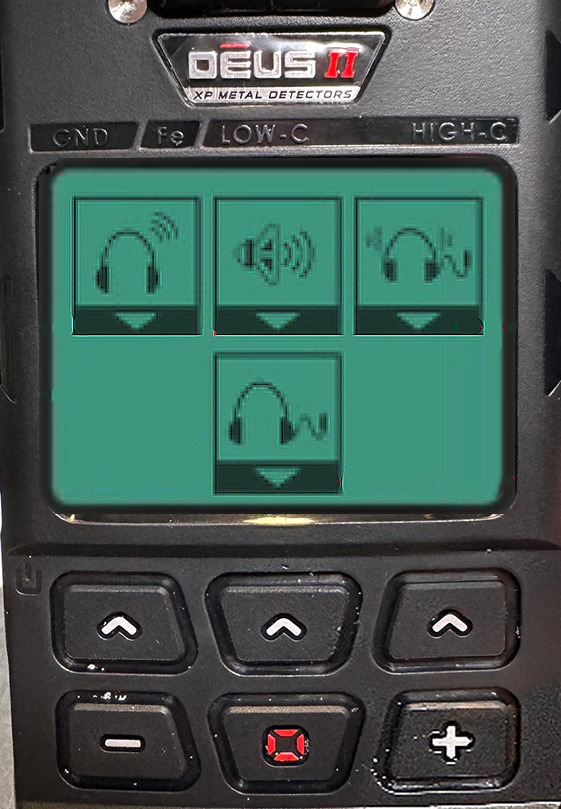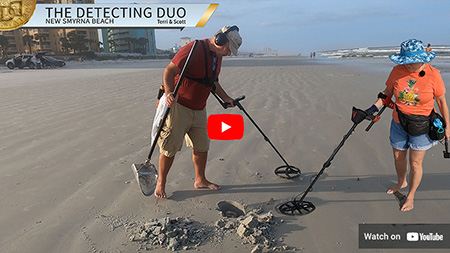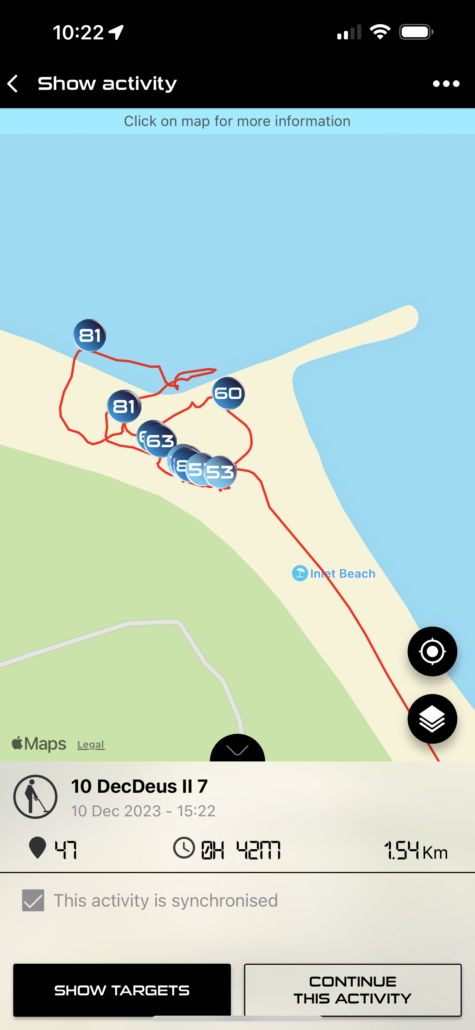XP DEUS II Review and Testing – 2023 December
1st time out with DEUS II
Overview and 1st Review
Disclaimer
This is not meant to be a full technical or Masters expert evaluation of the DEUS II. As we become more informed and expert in the use of the DEUS II, as related to other metal detectors in this class, then we will expand our learned experiences here.
It can take a long time to learn and master a new metal detector. This is the beginning of our journey.
This DEUS II was sent to us by XP to test and review. We are challenged to give a first impressions and overview.
We WILL make a lot of rookie mistakes with this metal detector, at first (some intentional, some not).
Overview
The XP DEUS II is the first full *wireless metal detector that uses fast multi-frequency with unique features and performance. It is an all terrain detector that can go from land to the beach to diving(up to 20 meters).
Our Amazon Affiliate Link to product suggested
It has a variety of coils, remote controls, headphones and pin pointers that can all communicate with each other wirelessly with no latency using the XP patented radio protocol system.
*One should note that it’s mostly wireless because when you plan to use this in water, you need an antenna wire attached.
Best when using all the bundled items found in the suggested kit where one gets the headphones, 11 inch FMF Search Coil and the MI-6 Pinpointer. All play well together.
An added addition is using the Go Terrain App . This app integrates with the DEUS II to track, log, map and document your finds in real time.
Setup
Setup is pretty straight forward. Connect the coil to the bottom stem, the remote to the top stem, adjust and ready to go.
Charge everything up and then when the remote is powered on, it will attempt to connect and turn on the coil. If not, pairing may be required. Then the audio source will be prompted for a selection. If wireless headphones are paired, select those as the audio source from the display.
Note that in the 1st video Scott had the coil mounted the opposite way round. Some “detector perfectionist” consider this wrong. Whilst it’s not the intended orientation, it technically does not affect the working ability of the coil. It will throw the center of balance toward the back and may not be as accurate in using the tip of the coil for pin pointing a target.
What we like
- Electro Magnetic Interference
- The DEUS II is excellent at eliminating EMI from sources like cell towers, microwave and wifi.
- Comparison:
- The Equinox 600 can only eliminate EM interference from sources by switching to mono frequency. Most EM is from the 10 kHZ, one of the pre-set multi-frequencies.
- The Vanquish 540 doesn’t have EM interference problems, either.
- Ergonomics
- Well balanced, light in the current configuration with an 11″ coil and remote mounted to the stock stem.
- The grip is curved and comfortable.
- Swinging the DEUS II with the current setup for long hours appears very good.
- Weight
- The DEUS II as seen in the video has the 11″ coil, stock stem and main remote which weigh in at about 2.5 lbs, or about 1,145 grams. Compare to my Equinox 600 which weighs in at about 2.9 lbs or ~1,332 grams. So the DEUS II is a tad lighter.
- It’s also about balance.
- It seems I can swing longer (3 hrs) on one arm with the DEUS II, but I need to switch with the NOX after every 45 minutes or so. It’s all subjective.
- The Vanquish 540 that Terri uses weighs in at around 2.8 lbs and seems to be more coil heavy.
 .
. 
- Display
- Basic LCD screen with ability to turn on backlight at different levels.
- Leaving the backlight on seems to have a minimal impact on battery usage.
- Excellent abundance of information is available on the main display screen.
- Turning on the Zoom display feature which pops the larger T ID, ferrous and non-ferrous display is a great feature. Note that this display pops on when one is over a target and will auto-switch back to the full information display.
- Basic LCD screen with ability to turn on backlight at different levels.

- Audio
- The variety tones available. Can be tailored to fit what one finds most pleasing and informative.
- The ability to run more than one audio source – i.e. Wireless Headphones and Remotes speaker.
- Independent adjustable volume levels.
- Great with both on when on video
- Mostly Wireless
- Headphones Wireless
- App Wireless
- Coil Mostly wireless
- Beach mode requires an antenna wire
- Reactivity
- Adjustable from slow recovery to very fast recover.
- This detector analyzes and moves on to the next target really quick!
- Menu Navigation
- Once you learn the basics, can easily get to any option or setting quickly.
- The buttons and many secondary options to get to you options quickly with long press
What we don’t like
- Remote Stem Connection
- When the remote is on the stem, it’s possible to easily bump it off. It can easily loosen and pop off if one doesn’t check every so often. In one instance whilst out in the surf, I bumped it and it was saved from dropping in the water by the Antenna wire connected to the remote. I’ve since added the included quick release strap around the stem and to the remote.
- Lower Stem Flimsy
- The upper stem appear to be aluminum. The lower stem appears to be plastic (needed to reduce coil metal detecting issues, I understand.) It flexes easily and can flop a tad.
Would be nice if this was stronger, say made of carbon fiber instead of plastic.
- The upper stem appear to be aluminum. The lower stem appears to be plastic (needed to reduce coil metal detecting issues, I understand.) It flexes easily and can flop a tad.
- Arm Rest not easily adjustable
- To change the Arm Rest, one has to undo a screw and move to one of 3 positions.
- We’d like to see this improved in the future to maybe a flip lock like the other parts of the stem.
- Antenna covers LED on coil
- In order to charge and see the LED working, one has to remove the Antenna block from the coil.
- Antenna connection to coil
- The antenna connection requires clipping on and then a band placed round to insure will stay in place. Oft times beach hunters like us spread sand with the coil (bad practice?) which can easily wear down this or break the band.
- Antenna connection to remote
- This seems moderate OK. Would prefer it mounts to the back rather than to the top via a clip and having to hang out to the side. Easy to catch on things and pull off.
- Charging Tri-cable
- The cable and charging method is fine, however 2 of the connectors used for the coil clip and headphones is old-school Mini USB. Would be nice if they wer current standard USB-C or magnetic connections.
Final Thoughts
Most of what I’m reviewing here is based on our current use on the beach locations only. We’ve used the DEUS II 3 times on the beach. First time out not a lot of fantastic finds, but beginner learning. And there’s a LOT to learn.
But the 3rd time out, I had found 2 rings down in the surf while using the Diving program (14kHz max). That impressed me most since we haven’t found any rings for a long time. One Silver and the other Gold Plated.
Was it because of the DEUS II? Could be. Could be it was just the luck of that day. Too many factors and variable to really say. But, the DEUS II is proving to find more targets per swing than we do with either of the Minelab detectors. Again, this is all subjective but a decent observation.
The DEUS II is a both a simple and complete machine. Yes, you can turn it on, choose a preset program and go.
But like me, you’re going to want to learn the machine, dig in, tweak the sound, tweak the Salt Sensitivity, change programs based upon location. With each trip out I am testing different settings to see what works best.
I’m using the stock programs, but modified based upon what some of the “experts” recommend for beach hunting as well as learning my own best settings.
In the surf or really wet areas, I’m finding that the Diving program working wonderful. No false singles and rock solid. My second more recent choice is the Beach P Program has treated me really well – with some alternate changes to the Salt Sensitivity to 8 and the Reactivity set to 1 to 1.5.
With each trip out we are finding more as I learn the programs and tweaks. We have been impressed with finding many more targets (or so it appears) than what we would normally find with both the Vanquish 540 and the Equinox 600. I only mention those because we have those as our tried and true reference detectors. My opinions will change as I test and learn more, and try other detectors in this class. Ideally, I think I need to test a Manticore and maybe a Nokta Legend.
The biggest thing one must learn with the DEUS II, or any detector for that matter, is to listen to the target. Understand that a soft tone may indicate a deep target, or small target, or both! There’s a lot of information being pumped into your ears.
The TID, X/Y screen, Ferrous and non-Ferrous visuals on the Remote screen simply back up what you are hearing.
Seeing only a small glimmer indication on the non-Ferrous side, or smaller graphic on the X/Y screen can mean the object is small or deep as well.
The Target ID will give one a clue as well as to the type of object it is. Once you learn the numbers being presented, then you can say “that’s a Nickel” or “that’s a Quarter” — for the U.S. beach hunts. And then surprised when it’s something different. The sound may help better define the object shape.
The DEUS II uses a scale from 0 to 99. A higher conductor will mean a higher Target ID. A higher pitch may also indicate a higher conductor as well.
With the Vanquish and Equinox we know and rely most of the time the Target ID values and the visual depth gauge presented on screen. Each bar indicates about 2 inch of depth.
On the DEUS II, the size of the image on the X/Y or amount filled in on the Ferrous or non-Ferrous bars can indicate the depth. But also the sound, being softer or louder.
So my final conclusion is, based upon what we currently use, this DEUS II is miles/kilometers ahead. It both pleases and challenges us on the beach. It appears to be finding more, giving more clues, and helping us to quickly get a target object out of the ground.
I hope to make this my main metal detector.





 2023 The Detecting Duo
2023 The Detecting Duo 2023 The Detecting Duo
2023 The Detecting Duo